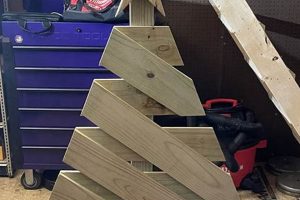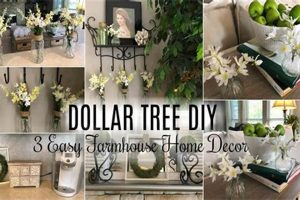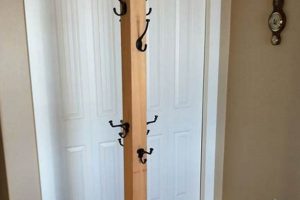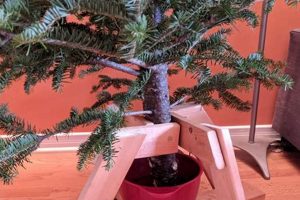Creating a decorative accent for the pinnacle of a holiday centerpiece, specifically a handcrafted ribbon embellishment designed to adorn the uppermost branches of a fir or artificial evergreen during the Yuletide season, represents a popular form of festive adornment. As an example, individuals may construct a multi-looped fabric ornamentation to finalize the presentation of their decorated pine.
The practice provides an avenue for personal expression and customization, allowing for a unique visual statement that reflects individual style and complements existing holiday decor. Its appeal extends from cost-effectiveness, utilizing readily available materials, to the satisfaction derived from producing a bespoke item. Historically, such handcrafted accents have been employed to impart a sense of warmth and personalization to holiday celebrations.
The subsequent discussion will explore the various methods, materials, and design considerations involved in fabricating such an item, offering guidance for both novice and experienced craft enthusiasts seeking to enhance their seasonal decorations. Considerations will be given to ribbon selection, structural techniques, and stylistic variations.
Fabrication Guidance
The following recommendations are intended to optimize the creation of a handcrafted decorative piece for a holiday tree, enhancing both aesthetic appeal and structural integrity.
Tip 1: Ribbon Selection: Employ wired ribbon. The internal wire allows for shaping and maintaining desired form, contributing to a more professional and lasting appearance. Consider coordinating ribbon textures and colors with the overall theme of the decorations.
Tip 2: Securing the Center: Utilize floral wire, zip ties, or sturdy thread to tightly bind the center of the fashioned loops. This ensures a secure, stable foundation for the structure and prevents unraveling.
Tip 3: Loop Consistency: Strive for uniform loop size during construction. Consistent loop dimensions result in a balanced and visually harmonious final product. Measure or mark ribbon sections to ensure uniformity.
Tip 4: Tailoring the Tails: Adjust the length and angle of the ribbon tails to complement the overall arrangement of the evergreen branches. Angled cuts can add visual interest and prevent a static appearance.
Tip 5: Structural Reinforcement: For larger or more elaborate creations, consider incorporating a hidden support structure, such as craft wire or a small dowel rod, to provide added stability.
Tip 6: Branch Integration: Affix the completed creation to the tree’s apex using floral wire or sturdy ornament hooks. Ensure the attachment is secure and evenly distributes the weight to avoid drooping or instability.
Tip 7: Material Quantity Assessment: Accurately estimate the quantity of ribbon required based on the desired size and complexity. It is generally advisable to purchase a surplus to account for errors or design adjustments.
Implementing these suggestions will contribute to a more refined and durable decorative feature, capable of withstanding the duration of the holiday season while enhancing the tree’s visual presentation.
The next section details considerations for adapting designs to suit various aesthetic preferences and spatial constraints.
1. Ribbon Selection
Ribbon selection represents a foundational element in the successful creation of a handcrafted decorative piece designed to adorn the apex of a Christmas tree. The materials properties, aesthetic qualities, and structural integrity directly influence the visual impact and longevity of the finished product. Accordingly, careful consideration of various ribbon attributes is paramount.
- Material Composition
Ribbons are available in various materials, including satin, velvet, burlap, and metallic fabrics. Each material offers a distinct texture, sheen, and level of durability. For instance, velvet ribbons impart a luxurious, opulent feel, while burlap provides a rustic, homespun aesthetic. The chosen material should align with the intended style and the overall decorative scheme. Furthermore, the materials resistance to fraying and its ability to hold its shape are critical factors affecting the ornaments longevity.
- Width and Pattern
Ribbon width dictates the scale and prominence of the loops and tails. Wider ribbons create a more voluminous and dramatic effect, while narrower ribbons offer a more delicate and intricate appearance. Pattern selection, including stripes, polka dots, or floral designs, introduces visual complexity and can complement existing decorations. The pattern’s scale should be proportional to the size and intricacy of the finished topper.
- Wired vs. Unwired Edges
Wired ribbon features thin wires along its edges, providing structural support and allowing for shaping and manipulation. This characteristic is particularly advantageous for creating defined loops and maintaining the ornament’s form. Unwired ribbon, while more pliable, lacks the structural integrity to hold complex shapes and may be better suited for simpler designs or embellishments. The presence or absence of wired edges significantly impacts the design’s complexity and the ribbon’s ability to retain its shape.
- Color Palette
The color palette should harmonize with the tree’s existing decorations and the overall holiday theme. Traditional color combinations, such as red and green or gold and silver, evoke classic holiday sentiments. However, alternative color schemes, such as blues and silvers or pastels, can create a modern or whimsical aesthetic. Color selection also affects the ornament’s visibility and its ability to serve as a focal point. High-contrast colors can draw attention, while monochromatic palettes create a subtle and elegant effect.
The aforementioned factors collectively contribute to the selection of appropriate ribbon for a “christmas tree bow topper diy”. A well-informed choice, considering these aspects, is essential for crafting a visually appealing and structurally sound festive ornament that complements the overall aesthetic of the holiday tree.
2. Loop Formation
Loop formation represents a critical stage in the creation process, significantly impacting the visual appeal and structural integrity of the final product. The technique employed in shaping and securing loops dictates the overall aesthetic and contributes to the ornament’s ability to maintain its form throughout the holiday season.
- Loop Size and Consistency
The dimensions of individual loops and the consistency thereof directly influence the overall symmetry and balance of the topper. Uniform loop sizes create a cohesive and visually pleasing arrangement, while variations can introduce asymmetry and a less polished appearance. Consistent loop size requires careful measurement and precise execution, particularly when working with wired ribbon.
- Loop Density and Layering
The number of loops and their arrangement in layers contribute to the perceived fullness and complexity of the decorative element. Higher loop density creates a richer, more opulent effect, while sparser arrangements offer a more minimalist aesthetic. Effective layering involves strategically overlapping loops to create depth and dimension, ensuring that each loop is visible and contributes to the overall design.
- Loop Orientation and Direction
The direction and orientation of loops impact the visual flow and perceived movement. Alternating loop directions, such as creating inward-facing and outward-facing loops, introduces dynamism and visual interest. The angle at which loops are positioned also affects the overall silhouette and can be used to create various shapes, such as a starburst effect or a more traditional circular form.
- Securing Techniques
The method used to secure loops at the center is crucial for the ornament’s structural stability. Employing floral wire, zip ties, or sturdy thread, tightly bound, prevents loops from unraveling and maintains the topper’s shape over time. The securing technique should be discreet, minimizing its visibility and preventing it from detracting from the overall aesthetic.
The interaction of these facets dictates the final look, illustrating the integral link between loop formation and the success of a “christmas tree bow topper diy” project. Mastery of these techniques translates to a more visually compelling and structurally sound piece, enhancing the overall festive presentation.
3. Secure Attachment
Secure attachment represents a crucial element in the successful implementation of any “christmas tree bow topper diy” project. The method by which the crafted adornment is affixed to the tree’s apex directly influences its stability, longevity, and overall visual presentation. A compromised attachment can result in drooping, displacement, or complete detachment, diminishing the intended aesthetic and potentially causing damage to the tree or surrounding decorations.
- Weight Distribution
The weight of the finished piece must be evenly distributed across the supporting branches. Concentrated weight on a single branch can lead to bending or breakage, compromising the visual integrity of the tree and the stability of the topper. Lighter materials and balanced designs are crucial to prevent undue stress on the branches. For example, a topper constructed primarily of lightweight wired ribbon is less likely to cause branch damage than one heavily embellished with weighty ornaments.
- Attachment Points
Multiple attachment points provide enhanced stability compared to a single point of contact. Distributing the securing force across several branches minimizes the risk of slippage or detachment. Employing floral wire to weave the topper into multiple branches near the tree’s crown offers a more secure and discreet attachment method than simply clipping it onto a single branch. The number of attachment points should be proportional to the size and weight of the topper.
- Material Compatibility
The materials used for attachment must be compatible with both the topper’s composition and the tree’s branches. Abrasive materials can damage delicate needles or scratch the surface of artificial trees. Corrosion-prone materials can weaken over time, leading to eventual failure. Using soft, pliable floral wire that is coated to prevent rust is a suitable choice for securing the topper without causing harm to the tree.
- Concealment
The attachment method should be as inconspicuous as possible to avoid detracting from the overall aesthetic appeal. Exposed wires or visible attachment points can disrupt the visual harmony of the finished product. Employing techniques such as tucking the wire behind the ribbon loops or using colored wire that blends with the branches helps to conceal the attachment mechanism and maintain a seamless appearance.
The aforementioned factors underscore the importance of careful planning and execution in securing a handcrafted ornament to the tree. A robust and discreet attachment method not only ensures the topper’s stability and longevity but also enhances its overall visual impact, contributing to a more polished and professional final presentation. It directly correlates to a successful “christmas tree bow topper diy”.
4. Style Adaptation
Style adaptation, within the context of a handcrafted festive tree ornament, constitutes the deliberate tailoring of design elements to harmonize with pre-existing decorative schemes and personal aesthetic preferences. Its significance resides in the capacity to transform a generic embellishment into a personalized statement, enriching the overall visual narrative of the holiday display.
- Color Palette Coordination
The selection of hues for the ribbon and embellishments should directly correlate with the existing color scheme of the tree and surrounding decorations. For instance, a tree adorned with traditional red and gold ornaments would benefit from a similar color palette in its apex ornament, while a modern, minimalist tree might warrant a topper employing silver and white tones. Failure to coordinate color palettes can result in visual disharmony, detracting from the overall aesthetic cohesion.
- Thematic Consistency
The chosen design and materials should align with the overarching theme of the holiday decor. A rustic, woodland-themed tree might incorporate burlap and natural elements like pinecones into its apex adornment, whereas a more formal, elegant tree would be better complemented by satin ribbons and crystal accents. Incongruent thematic elements can create a disjointed and aesthetically unappealing presentation.
- Material Texture Integration
The textures of the ribbons and embellishments should complement the textures of other decorative elements on the tree. A tree featuring predominantly smooth, glossy ornaments might benefit from the addition of textured ribbons, such as velvet or brocade, to provide visual contrast and tactile interest. Conversely, a tree with heavily textured ornaments might be better suited to smooth, satin ribbons that offer a sense of visual calm.
- Scale and Proportion Harmonization
The size and proportions of the topper must be in scale with the overall dimensions of the tree. A disproportionately large topper can overwhelm a smaller tree, while a too-small topper can appear insignificant and visually lost on a larger tree. Careful consideration of the tree’s height and width, as well as the density of its branches, is crucial for selecting a topper that is visually balanced and harmonious.
These elements of style adaptation, when thoughtfully implemented, elevate a simple handcrafted piece into a cohesive and visually compelling element of the overall holiday display. This elevates what is simply “christmas tree bow topper diy” into a fully realised creative project. Consideration of these elements results in a sophisticated and personalized holiday presentation, reflecting individual style and attention to detail.
5. Size Considerations
The dimensions of a handcrafted festive tree ornament must be carefully considered, impacting its visual harmony, structural stability, and overall integration with the tree’s existing elements. Optimal size balances prominence and proportionality, avoiding both overshadowing and insignificance. A well-calibrated size enhances the overall aesthetic of the holiday display.
- Tree Height and Width
The overall height and width of the evergreen establish the appropriate scale for the apex adornment. A towering, broad tree can accommodate a larger, more elaborate ornament, while a smaller, slender tree necessitates a more diminutive piece to maintain visual equilibrium. For instance, a 9-foot tree may require a 18-24 inch topper, while a 6-foot tree is better suited to a 12-16 inch design. Neglecting these proportions results in a visually imbalanced composition.
- Branch Density and Strength
The density and load-bearing capacity of the branches dictate the maximum weight and dimensions of the topper. A tree with sparse, delicate branches cannot support a heavy, oversized ornament without sagging or damage. Conversely, a tree with dense, sturdy branches can accommodate a more substantial piece. Assessing branch strength prior to crafting ensures stability and prevents visual disruption. A skeletal tree with a full topper will not give the desired look and will be an eyesore.
- Ribbon Width and Loop Volume
The width of the selected ribbon and the volume of loops directly influence the apparent size of the finished product. Wider ribbons and more voluminous loop arrangements create a larger, more prominent piece, while narrower ribbons and fewer loops result in a smaller, more understated design. Adapting ribbon width and loop volume to the tree’s scale enhances visual harmony. Ensure the volume of loops and width of ribbons are not bigger than the tree width.
- Embellishment Scale
The scale of any embellishments, such as ornaments, berries, or pinecones, must be proportional to the overall size of the topper and the tree. Oversized embellishments can overwhelm the design and detract from its visual appeal, while undersized embellishments can appear insignificant and lost within the arrangement. Maintaining a consistent scale among all elements contributes to a cohesive and balanced aesthetic.
These dimensional relationships underscore the importance of thoughtful planning in any “christmas tree bow topper diy”. Careful consideration of these parameters allows for the creation of a handcrafted piece that seamlessly integrates with the tree, enhancing its overall aesthetic and contributing to a visually pleasing holiday display. It is not simply about how big the bow is, it is about how it looks with the tree.
Frequently Asked Questions
The subsequent section addresses common inquiries and misconceptions regarding the design, construction, and implementation of handmade tree apex decorations.
Question 1: What type of ribbon is most suitable for creating a durable and aesthetically pleasing design?
Wired ribbon, characterized by its internal wire reinforcement, offers superior structural integrity and allows for greater manipulation in shaping and maintaining desired forms. While unwired ribbon can be incorporated, wired ribbon is generally recommended for its enhanced durability and design versatility.
Question 2: How does loop density affect the final visual presentation of a handmade design?
A higher concentration of loops creates a fuller, more opulent appearance, while a sparser arrangement yields a more minimalist aesthetic. The optimal loop density depends on the desired style and the overall dimensions of the tree. A sparse tree may look fuller with a denser topping.
Question 3: What materials are recommended for securely attaching a handcrafted piece to the tree’s uppermost branches?
Floral wire, zip ties, or sturdy thread are suitable for securing the apex decoration. These materials offer sufficient strength to support the ornament’s weight while remaining relatively inconspicuous. Ensure materials do not contain substances that could damage the tree.
Question 4: How can color schemes be effectively coordinated to complement existing tree decorations?
The selection of hues should align with the dominant colors present in the tree’s existing ornament collection. Consider employing complementary colors or analogous color schemes to create visual harmony. High contrast coloring can distract from the other design elements.
Question 5: How do tree height and width influence the ideal dimensions of a handcrafted ornament?
The apex decoration’s size should be proportional to the tree’s overall dimensions. A larger tree can accommodate a more substantial design, while a smaller tree requires a more diminutive piece to maintain visual balance. Ensure to test the topper with the tree before permanently installing it.
Question 6: What techniques can be employed to conceal the attachment mechanism and maintain a seamless aesthetic?
Tucking the securing wire behind ribbon loops or using colored wire that blends with the tree’s branches are effective strategies for concealing the attachment and preserving the ornament’s visual integrity. A seamless topper should look as if it is not attached at all.
In conclusion, a thorough understanding of these common concerns and the implementation of appropriate techniques will contribute to the successful creation and integration of a handcrafted apex adornment, enhancing the overall aesthetic of the holiday tree.
The subsequent section will provide a summary of key points and best practices for crafting and implementing a high-quality festive piece.
Conclusion
The preceding discussion has illuminated the multifaceted considerations inherent in the creation and implementation of a “christmas tree bow topper diy”. Key aspects addressed include ribbon selection, loop formation, secure attachment methodologies, stylistic adaptation to existing decor, and the critical importance of proportional sizing. Mastery of these elements directly impacts the visual cohesion, structural integrity, and overall success of the handcrafted ornament.
The information presented herein serves as a practical guide for individuals seeking to enhance their holiday decor through personalized, handcrafted elements. Diligent application of these principles will result in a festive display that reflects individual creativity and attention to detail, thereby elevating the overall ambiance of the holiday season. Further exploration of advanced techniques and material experimentation is encouraged to continually refine the art of crafting holiday adornments.







